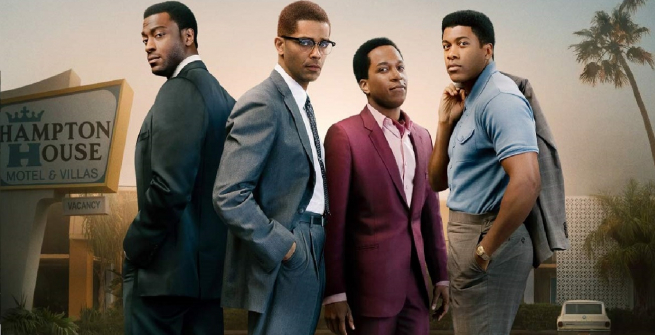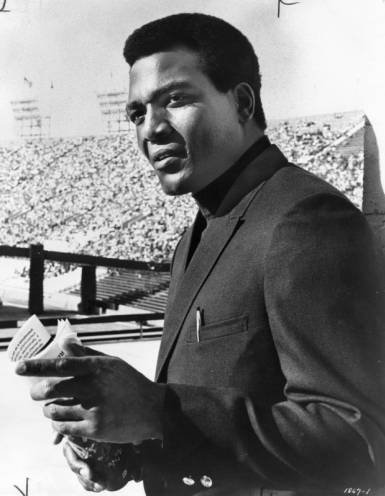On February 25, 1964, 22-year-old boxer Cassius Clay defeated the heavily favored Sonny Liston to win the heavyweight boxing title in Miami Beach, Florida. Three of his closest friends were in attendance that night: the civil rights activist Malcolm X; musician and SAR record label owner Sam Cooke; and Cleveland Browns’ fullback and actor Jim Brown.
After Clay’s victory, the four men celebrated at the Hampton House Motel, a segregation-era motel where many Black celebrities stayed when they visited Miami. No one knows what exactly the four men discussed that evening, but shortly afterward, Cassius Clay publically joined the Nation of Islam and changed his name, first to Cassius X, and then to Muhammad Ali.
One Night in Miami, a film directed by Regina King and based on a 2013 play by Kemp Powers (who also wrote the screenplay), imagines what might have happened in that hotel room. While the conversation between the four men is fictionalized and some timelines are slightly altered for dramatic emphasis, many details from the play and film really happened.
With electrifying performances by Kingsley Ben-Adir as Malcolm X, Eli Goree as Cassius Clay, Aldis Hodge as Jim Brown, and Leslie Odom Jr. as Sam Cooke, the film is powerful and fascinating in its exploration of the bonds between the four men, and their feelings about the civil rights movement and what it means to be a Black man in the United States.
After watching the film, I immediately wanted to know more about what each man was doing around February 1964 and discovered that all four spent significant time in Los Angeles in the months leading up to that significant night in Miami.
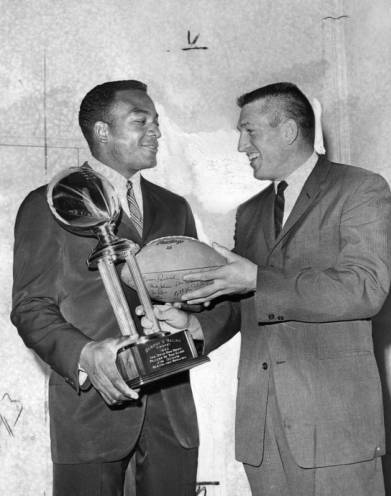
Football stars Jim Brown and John Unitas at a January 9, 1964 party held in advance of the NFL Pro Bowl, [1964]. Herald Examiner Collection
Jim Brown was in Los Angeles in January 1964 to play in the NFL Pro Bowl at Los Angeles Memorial Coliseum. There, Brown says he was approached by someone from 20th Century Fox, who told him he should go to the studio lot for a screen test. Brown said, “I broke into Hollywood the old-fashioned way.” In March 1964, Brown shot Rio Conchos, a western film where he plays a Buffalo soldier, which he followed up with a supporting role in The Dirty Dozen and over three decades of steady work in television and film.
In addition to being an athlete and actor, Brown was also an outspoken activist in the Black freedom struggle. Though he frequently defended the Nation of Islam against mainstream media depictions that were inclined to equate them with terrorist or white nationalist groups, he never joined NOI. Instead, Brown threw his activist energy into founding the Black Economic Union, an organization with offices across the country, including one in Los Angeles, that gave seed money to help launch hundreds of Black-owned businesses.
Sam Cooke was the only one of the four men living in Los Angeles in 1964. He and his wife, Barbara, were living in Los Feliz, and Cooke was running his record label SAR out of offices on Hollywood Boulevard.
In late December 1963, Cooke had begun to play a new song for close friends, something more personal, political, and immediately related to the civil rights movement than his previous work. Less than a month before the night in Miami, Cooke recorded “A Change Is Gonna Come” at the RCA studio at Sunset and Vine, and played it live just a few days later on The Tonight Show with Johnny Carson. While this differs slightly from the timeline presented in One Night in Miami, the song would become an anthem of the civil rights movement and widely regarded as one of the most powerful and iconic ever recorded.
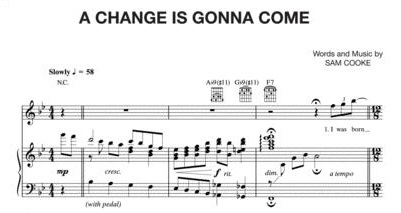
Malcolm X spent significant time in Los Angeles in 1962 and 1963, when he came to the aid and support of members of the Nation of Islam’s Los Angeles mosque following a violent act of police brutality. In 1962, Los Angeles Police Commissioner William H. Parker had ordered surveillance on the mosque, and on April 27, officers stopped two Black men they observed taking clothes out of the backseat of a car parked nearby. Mosque members gathered around the arrest in progress, and when tensions escalated, one officer fired a shot that hit another officer in the arm. Police backup arrived and carried out a raid on the mosque, beating and shooting at the backs of retreating Muslims, leaving one man dead and six wounded.
Fourteen Black Nation of Islam members were charged with felony assault and resisting arrest. Malcolm X returned to Los Angeles in May 1963 for their trial where 9 of the 14 were found guilty. No police officers were charged in the violence.
One Night in Miami depicts Malcolm X’s growing uneasiness with Nation of Islam leader Elijah Muhammad, and biographers write that Muhammad’s response to the raid and killings, which Malcolm X viewed as lacking and passive, was a major cause of their rift. Malcom X would formally break with Muhammad and the Nation of Islam just two weeks after the events depicted in One Night in Miami.
Cassius Clay’s time in Los Angeles was markedly different from his friend, Malcolm X’s. While in 1962, Malcolm X was speaking out against Los Angeles Mayor Sam Yorty, Clay did a photo op at City Hall inviting Yorty to his bout against Alejandro Lavorante.
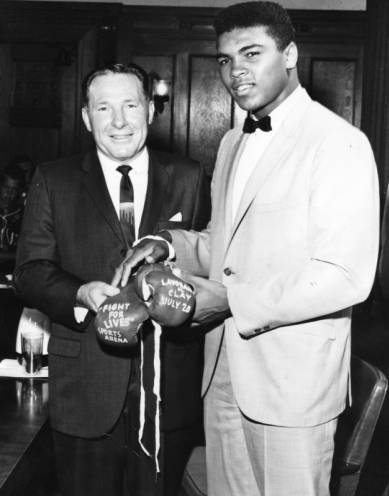
In this July 25, 1962 photo, Cassius Clay appeared at City Hall to invite Mayor Sam Yorty to his bout with Alejandro Lavorante at the Sports Arena, Herald Examiner Collection
Clay predicted “Lavorante will fall in five,” and proceeded to knock him out with a left hook in the fifth round.
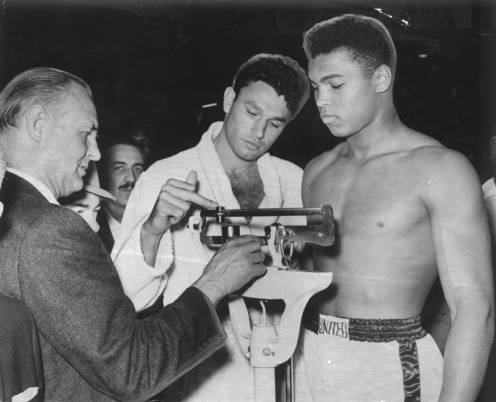
Cassius Clay weighs in before his bout with Alejandro Lavorante, [1962]. Photo credit: Larry Miller, Herald Examiner Collection
Between the bout with Lavorante and the heavyweight title fight, Clay faced four more challengers, including aging veteran Archie Moore in a sold-out “Battle of the Ages” at the Los Angeles Sports Arena. During that time, his friendship with Malcolm X deepened, and while Clay’s career was being managed by wealthy white men, his heart and mind were increasingly loyal to the Nation of Islam, and to Malcolm X, whom he viewed as an older brother. Malcolm X admired the way Clay spoke his mind and refused to be controlled by his white trainers and managers, and also recognized that Clay would be a powerful figurehead and advocate for the Nation of Islam.
By the next time Cassius Clay was in Los Angeles, in August 1964, his name was Muhammad Ali. However, by that time, Malcolm X had parted ways with the Nation of Islam, and it was Muhammad Ali seated next to Elijah Muhammad at the Olympic Auditorium during a Nation of Islam rally.
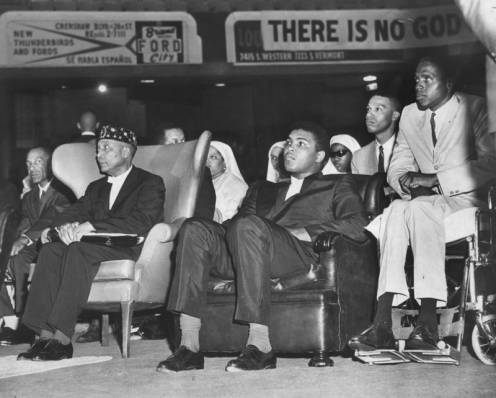
Muhammad Ali sits onstage at the Olympic Auditorium next to Nation of Islam leader Elijah Muhammad on August 9, 1964, Herald Examiner Collection
Ali would follow in the footsteps of Malcolm X, embracing the doctrines of Sunni Islam, and pulling away from the more separatist interpretations of the NOI under Elijah Muhammad’s leadership. He would also settle in Los Angeles, living in the Hancock Park neighborhood in the 1970s and 1980s.
These are, of course, just small slivers of the lives of these four important and complicated men, each of whom left a mark on history through their professional successes and their activism. For further reading, here are just a few excellent titles to explore.
